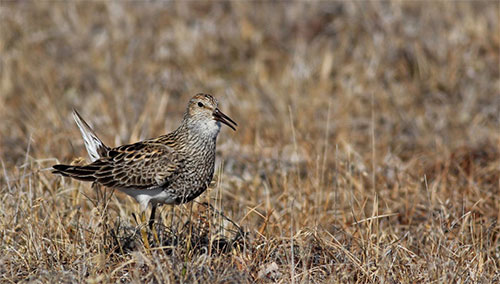
Alaska's shorebirds exposed to mercury
July 13, 2016
Wednesday PM
(SitNews) - Shorebirds breeding in Alaska are being exposed to mercury at levels that could put their populations at risk, according to new research from The Condor: Ornithological Applications.
Thanks to atmospheric circulation and other factors, the mercury that we deposit into the environment tends to accumulate in the Arctic. Mercury exposure can reduce birds' reproductive success and sometimes even be lethal. Shorebirds may be particularly vulnerable because they forage in aquatic environments where mercury is converted into methylmercury, its most dangerous form. Marie Perkins of the Biodiversity Research Institute (BRI) and her colleagues investigated the level of mercury in Alaska's shorebirds and found that some birds breeding near Barrow, at the state's northern end, have mercury concentrations upwards of two micrograms per gram of blood.

Pectoral Sandpipers and other shorebirds are being exposed to high levels of mercury in Alaska according to new research.
Photo By B. Lagasse, courtesy The Condor: Ornithological Applications
"These species already face a lot of tough new challenges, from climate change to disappearing stop-over habitat, so throwing a neurotoxin in the mix that can reduce reproductive success is likely to harm their populations," according to Dan Cristol of the College of William & Mary, an expert on mercury in birds who was not involved with the new study. "The mercury concentrations reported in this paper are likely to reduce reproduction, but not catastrophically, based on what we know from other species. What may be even worse, though, is that these mercury levels probably spike when they leave the breeding grounds and start burning their reserve fuel, making their already arduous continent-jumping trips even harder."
To assess the birds' mercury exposure, Perkins and her colleagues collected blood and feathers from nine shorebird species breeding and staging for their southward migration at sites throughout Alaska. In addition to the troubling results from birds breeding near Barrow, they found that mercury levels depended on a species' foraging habits--shorebird species that foraged in upland areas, away from methylmercury-rich wetlands, had the lowest blood mercury concentrations.
More work is needed to determine how much mercury various shorebird species can handle before they suffer adverse effects. "These results have encouraged me to expand my research on mercury exposure in Arctic shorebirds," says Perkins. "I am currently pursuing my PhD at McGill University, where I am working in collaboration with BRI and the Arctic Shorebird Demographics Network to closely examine mercury exposure in multiple shorebird species breeding across the North American Arctic."
On the Web:
"Mercury exposure and risk in breeding and staging Alaskan shorebirds"
http://www.aoucospubs.org/doi/full/10.1650/CONDOR-16-36.1
The Condor: Ornithological Applications.
Volume 118, Issue 3 (August 2016)
http://www.aoucospubs.org/toc/cond/118/3
Edited by Mary Kauffman, SitNews
Source of News:
The Condor: Ornithological Applications
http://www.aoucospubs.org
The Condor: Ornithological Applications is a peer-reviewed, international journal of ornithology. It began in 1899 as the journal of the Cooper Ornithological Club, a group of ornithologists in California that became the Cooper Ornithological Society.
Representations of fact and opinions in comments posted below are solely those of the individual posters and do not represent the opinions of Sitnews.
Publish A Letter in SitNews
Contact the Editor
SitNews ©2016
Stories In The News
Ketchikan, Alaska
|
Articles &
photographs that appear in SitNews may be protected by copyright
and may not be reprinted without written permission from and
payment of any required fees to the proper sources.
E-mail your news &
photos to editor@sitnews.us
Photographers choosing to submit photographs for publication to SitNews are in doing so granting their permission for publication and for archiving. SitNews does not sell photographs. All requests for purchasing a photograph will be emailed to the photographer.
|
|

